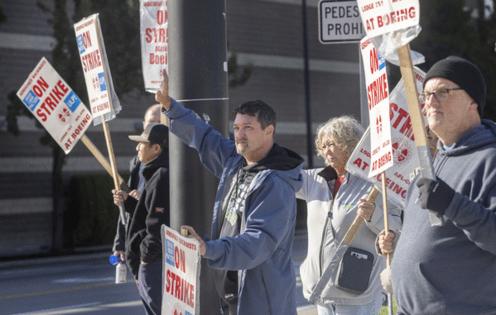Boeing Machinists appear split on offer to end strike as they cast ballots
Published in Business News
Boeing Machinists will vote Wednesday on whether to accept the latest contract offer and end their month-old strike or to reject it and stay out.
On a day when Boeing has announced another staggering quarterly loss in excess of $6 billion, the planemaker’s financial fate and potential layoffs across the aerospace industry hang in the balance.
After a 95% rejection of the initial contract offer in a September vote, interviews with Machinists since the latest proposal was published Saturday show a marked divide over the new offer — with the outcome too close to predict.
Voting closes at 5 p.m. The result — requiring a simple majority — will be announced at Machinists union headquarters in Seattle and is expected after 9 p.m.
The company offer would give the 33,000 Machinists a 35% wage increase over four years, which with compounding each year would bump up Machinist base pay by just shy of 40% by the end of the contract in 2028.
That would more than claw back the buying power lost to high inflation over the past 10 years, a decade during which Boeing gave the Machinists a total of 8% in wage increases.
“Overall, the offer is great,” said Jackie Vaden, 57, who works as a team lead making fuselage insulation in Everett and has been at Boeing 36 years. “I just hope people are grateful and vote accordingly.”
Other machinists say they’ll hold out for another major demand that Boeing has flatly refused to concede: restoration of the pension the union was forced to give up in the bitterly fought 2014 contract.
“I’m totally aware we should have our pension back,” said Vaden. “But it’s a reality. We lost it. It’s not coming back.”
Yet for Jesse Ballou, 38, who works on the 777/777X program in Everett, Washington, and has been 14 years at Boeing, that’s the sticking point.
The offer “is better, but it ain’t good enough,” he said. “Give me a pension and it’s sold.”
Jake Reis, 51, another 777/777X worker who has 13 years at Boeing, said he was still undecided Monday but leaning toward accepting the offer.
After “playing around with the numbers” posted on the union website to illustrate exactly what the offer would mean for the wages of people at specific grade and seniority levels, Reis said he’d moved from an initial “no” vote to “maybe yes.”
For some, there are other stumbling blocks besides the lack of a pension.
Andrew DeFreese, 35, who has worked at Boeing for 13 years, said he plans to vote against it because he wants a contract that allows workers to progress through the wage scales faster and that affords employees more paid time off.
DeFreese, an equipment operator in Everett, said he also wants to see a 40% general wage increase over three years, not four.
The pension isn’t a high priority for him, he said. He was a new hire when it was frozen in 2014, so he never planned his retirement around it. Yet he’s willing to stay on the picket line to support those who want it back because he saw how the change devastated some of his midcareer colleagues.
“The removal of it really threw a wrench in their retirement plans,” DeFreese said. “That was a gut punch for them.”
“If Boeing said ‘pensions are back tomorrow’ and that’s all they added to this contract, it would pass 100%,” DeFreese said.
Rachel Sarzynski, 51, a team lead on the 777 who has worked at Boeing 17 years, said the strike has gone on long enough that “some people are desperate” and will say yes to start getting paid again.
She says this latest offer has “absolutely divided people.”
She is a no vote. “I haven’t been on strike this long to stop at this,” Sarzynski said.
The impact if Boeing’s offer is rejected
If the contract offer falls short, it will stall the restructuring that new Boeing CEO Kelly Ortberg aims to put in place.
Outside Boeing, its suppliers will look to cut back further on production, with more furloughs and layoffs likely.
And retail businesses around the Puget Sound region will gird for continued lower spending by Machinists on strike.
Boeing was in dire straits before the strike started.
The quality lapses that led to the fuselage blowout on Alaska Airlines Flight 1282 in January drew a safety clampdown by the Federal Aviation Administration that slowed 737 Max production in Renton, Washington.
And a new design flaw discovered on the 777X flight test airplanes means that long-delayed airplane’s entry into service slipped out another year into 2026, so that jet production in Everett is even slower.
Earlier this month, the company shared third-quarter financial results including $5 billion in write-offs. At the end of the quarter, Boeing will have more than $45 billion in net debt and just over $10 billion in cash on hand.
With the credit rating agencies threatening to lower Boeing’s debt rating to junk bond status — a move that would greatly increase the cost of raising more capital — the company has set up a potential equity and debt sale for up to $25 billion to ensure it can survive.
But unless the rating agencies force its hand, Boeing will want to conduct such a sale only after the strike ends. Investors will pay more for stock in a company that shows signs of restored stability.
Further details on the financial situation are coming Wednesday as Ortberg for the first time publicly lays out his vision for Boeing’s recovery from five years of relentless setbacks.
A vote by the Machinists to end the strike could be seen as a starting gun for his recovery plan.
There’s no doubt the stock price would jump in response. When the Machinists return and begin ramping up production of 737 Maxes, the cash will begin to flow again.
Ortberg will have much more to do given the challenge ahead. He has already decided he wants to cut the workforce by 10%. He’s ending the 767 jet program in 2027. He needs to turn around the defense and space programs that are also bleeding cash.
But ending the strike is the first necessary step in any Boeing plan to recover.
And more than Boeing’s fate hinges on Wednesday’s vote. Suppliers are watching intently, for if the strike continues the flow of parts to Boeing will likely have to dry up completely.
Spirit AeroSystems of Wichita, Kansas, has already implemented three-week furloughs for 700 employees.
If the strike doesn’t end Wednesday, Spirit spokesperson Joe Buccino said there will likely have to be “significant further layoffs.”
Smaller suppliers are also bracing for the vote result.
Daniele Cagnatel, CEO of Renton-based Sekisui Aerospace, said “we are on a waiting pattern to see how Boeing will react and readjust their inventory levels.”
Trevor Skelly, an aviation consultant who previously ran the Collins Aerospace cabin interiors plant in Everett, said furloughing people can produce much longer-term disruption as suppliers learned from impact of the downturns from the COVID-19 pandemic and the long 737 shutdown after the Max grounding in 2019.
“A lot of them don’t return back to work,” said Skelly. “So that when things do return to normal, you have capacity issues, resource issues and skill shortages.”
If the Machinists vote to reject, retail businesses that depend on their spending money will feel the pinch.
But if they vote to go back to work, with a big bonus for ratification, those businesses can expect happier holiday spending.
What machinists would gain from this offer
The Machinists union District 751 union website lays out how the company proposal affects individual wages.
Take for example a Grade 4 machinist, one performing basic airplane assembly work. If that person has been at Boeing more than six years, he or she is at the top of pay scale for that grade and earns a basic wage without overtime of $42.99 per hour, or about $89,000 a year.
At the end of the four years, this contract offer would bump that person up to $60.09 per hour, or about $125,000 a year, a 39.8% increase.
A Grade 4 machinist with only two years at Boeing earns much less but receives an extra 50 cents per hour every six months until they reach the maximum pay level and so would see an even larger percentage boost in pay.
Receiving $26.50 per hour currently, or about $55,000 a year, the wage of a two-year machinist would rise after four years to $41.61 per hour or about $86,500 per year, a 52% increase.
Then as soon as that Machinist reaches their six-year hiring anniversary, they would zoom to the $60.09 per hour top-of-the-scale rate.
These figures include the general wage increases in the offer plus a cost-of-living increase for 2024, but not the still-unknown cost-of-living increases that will be granted in the next three years.
While a 40% wage increase may seem generous, for the Machinists it’s a matter of getting back what inflation and low wage hikes took away over a decade.
Since the contract extension 10 years ago, their total of 8% pay increases lagged seriously behind increased costs.
During that decade, much higher pay at Amazon and other fast-growing tech companies inflated living costs throughout the region, especially housing costs. Then, during and after the COVID-19 pandemic, general inflation spiked the cost of everything from gas to groceries across the nation.
An analysis this week by The Air Current, an online aviation news service, estimated that Machinist pay since 2014 fell “nearly 20 percentage points short of regional inflation.”
The analysis, which assumes more typical inflation of 3% per year over the course of the contract, concludes that the 12% pay boost in the first year of the proposed contract isn’t enough to catch up but further increases totaling 23% over the three subsequent years achieve that and “will provide an enormous boost for machinists.”
Scott Mikus, aerospace analyst with investment firm Melius Research, said that in industries where labor has power, from autoworkers to longshore workers, unions are insisting on clawing back their lost buying power.
“This is a time when skilled labor across the country has a lot of negotiating power,” said Mikus.
And the Machinists union has won from Boeing additional compensation beyond general wage increases.
The union wage examples cited above don’t include the annual bonus, which Boeing’s offer guarantees for the first time at no less than 4% of total pay each year, up to a maximum of 6%. And if the contract is ratified with a yes vote, each machinist will get a one-time $7,000 bonus.
The pension problem
Boeing insists it cannot afford to restore the pension.
Mikus points out that in the year before the pension was frozen, Boeing paid $1.5 billion into its employee pension plans to ensure they were fully funded.
“That’s a lot of cash flow,” he said.
The estimate by Ron Epstein, aerospace analyst with Bank of America, is it would cost Boeing about $1.6 billion a year to give all employees a pension. And if Boeing gave it to the Machinists it might have to grant it to all employees.
Epstein suggests a cheaper route to a defined benefit pension, rather than Boeing having its own pension plan, would be for the company to fund an annuity for each employee, essentially outsourcing the pension so the rating agencies don’t count it as debt. That could reduce the annual cost to $600 million, Epstein said.
But Boeing has been adamant it won’t consider restoring a defined-benefit pension.
Instead, Boeing proposes increasing the company contributions to a machinist’s 401(k) retirement plan.
Boeing will automatically contribute 4% of total annual pay to the 401(k), plus match the employee’s contributions up to an additional 8%. The offer also includes a one-time $5,000 contribution to the retirement plan of each Machinist.
In addition, Boeing will boost the pension payout for veteran Machinists who were at the company before the pension was frozen. The monthly payout will rise from $95 to $105 per year of service before 2014.
Distrust of the union by some rank-and-file
Even retired Boeing executives speaking privately acknowledge that a major driver of this strike is the bitterness left from that contract forced down the Machinists’ throats in 2014.
They had to give up their pensions and accept minimal raises to secure the 777X for this region. And that only went through after maneuvering by the Machinists national headquarters engineered a vote while many more senior machinists were on vacation.
So on this go round, the most militant machinists, still very distrustful, have angrily railed against the Local 751 leaders and accused them of colluding with Boeing.
Rob Davis, a 13-year Boeing mechanic who assembles aircraft wire bundles in Everett, points out that the union has paid out so far about $1,000 in strike pay to each of the 33,000 machinists and also lost about $100 in monthly dues from each one.
That’s $33 million the union is out, which Davis sees as motivating it to settle.
Although the union leadership is not formally recommending acceptance of the offer, it’s clear from the positive way it has presented it to the rank-and-file members that they favor it.
But that needn’t be read with cynicism. In an interview, District 751 president Jon Holden was clear he believes this may be the best contract the IAM can hope for.
As the entire community in the Puget Sound area awaits the result, both Boeing and the union leadership may be hoping for a “yes” vote on the contract.
If the rank-and-file note no, the strike will go on and the pain will widen as Machinists dig in to take back more from Boeing.
(Seattle Times reporter Lauren Rosenblatt contributed.)
©2024 Los Angeles Times. Visit at latimes.com. Distributed by Tribune Content Agency, LLC.












Comments